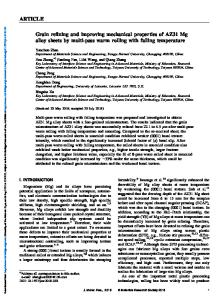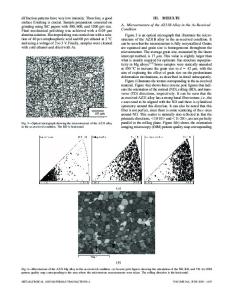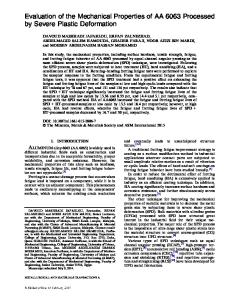Mechanical properties of AZ31 Mg alloy recycled by severe deformation
- PDF / 471,051 Bytes
- 7 Pages / 585 x 783 pts Page_size
- 54 Downloads / 372 Views
Mamoru Mabuchib) Department of Energy Science & Technology, Graduate School of Energy Science, Kyoto University, Yoshidahonmachi, Sakyo-ku, Kyoto 606-8501, Japan (Received 11 June 2005; accepted 14 December 2005)
AZ31 Mg machined chips were recycled by extrusion at 673 K with a low extrusion ratio of 45:1 and a high extrusion ratio of 1600:1. Oxide contaminants were dispersed more uniformly in the recycled specimen with the high extrusion ratio than in that with the low extrusion ratio. In tensile tests, the recycled specimens with the high extrusion ratio showed about 50% higher 0.2% yield stress and about 20% higher tensile strength compared with those of the reference specimens, which were the extruded AZ31 Mg blocks under the same conditions as the recycled specimens. The improvement of the tensile properties was attributed not only to the small grain size, but also to the dispersed oxide contaminants.
I. INTRODUCTION
Mg alloys are currently the lightest alloys used as structural metals, and Mg products have been used as structural materials such as automobile parts.1 To satisfy further demands of Mg alloys, it is necessary not only to attain good characteristics, such as a high strength and a high corrosion resistance, but also to develop useful recycling processes. Several recycling processes, such as remelting,2 have been proposed and carried out. Recently, “solid-state recycling” by hot extrusion has been proposed as a new recycling method for Mg alloy scraps.3–8 In the recycling process, metal scraps are directly recycled by hot extrusion. The Mg alloy recycled from machined chips showed a high strength due to the grain refinement and dispersion of oxide contaminants.3 In our previous study,7 we showed that oxide contaminants are distributed parallel to an extrusion direction. In general, air-formed oxide films on Mg–Al alloys are mainly composed of a mixture of MgO and Al2O3.9 When oxides are dispersed uniformly, particle-dispersion strengthening can be attained in the recycled Mg alloys, leading to upgrade recycling. In previous studies, the effects of oxide contaminants on the strengthening mechanisms of the recycled specimens have not been quantitatively investigated, and the effects of extrusion ratio on oxide dispersion in the Address all correspondence to these authors. a) e-mail: [email protected] b) e-mail: [email protected] DOI: 10.1557/JMR.2006.0090 754
J. Mater. Res., Vol. 21, No. 3, Mar 2006
recycled specimens have not been investigated. In this study, AZ31 Mg machined chips were extruded with a high extrusion ratio of 1600:1 to obtain a uniform oxide contaminant dispersion by severe deformation, and strengthening mechanisms were quantitatively investigated using existing models, on the basis of the results of tensile tests and microstructural observations. II. EXPERIMENTAL
Machined chips with average dimensions of 12 mm × 1.9 mm × 80 m from AZ31 (Mg–3 mass% Al–1 mass% Zn–0.5 mass% Mn) Mg alloys were prepared as Mg alloy scraps. The scraps were placed in a cylindrical contai
Data Loading...











